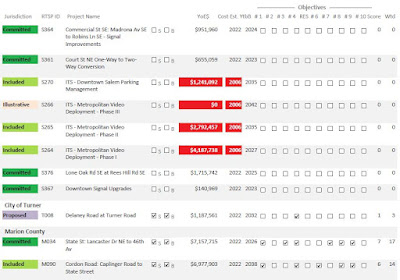It has been difficult to figure out what to say about the MTP project rankings. The important decisions are on what's in and out of the shorter-range TIP. Those are actual funding decisions.
What's in or out of the long-range MTP is provisional, able to be modified in the four-year intervals between updating it, and also able to be modified in the actual funding decisions for the near-term TIP.
 |
| Seattle Times on climate and salmon |
So what I want to focus on here is the weirdness of our scoring rubric, under consideration at the Tuesday meeting of the Policy Committee for our local Metropolitan Planning Organization.
Here are the final two pages of the Salem candidate project list, which has nearly 14 full pages in the packet. At the far right is the column header "wtd," short for weighted. The highest scoring projects have a weighted score of 17. The ones on these final two pages top out with score no more than 4. These are very low scoring projects!
 |
| Penultimate page of low rankings (13/14) |
But look at all the green "committed" tags. Some of them score a zero even! Those are projects with funding attached in the near term.
A committed project is one that has funding identified (including local match) and will be built within the next five years. The project is typically also in the TIP. Projects that are listed as included have the highest priority to be constructed in the next 20 years, and funding is reasonably anticipated to be available. [Illustrative and proposed projects are outside the "reasonably anticipated" funding, and are lower priorities.]
So our current scoring system does not correspond very well with actual funding decisions. There is an empirical disconnect here. What we say we value doesn't always correspond with what we actually value in budget decisions.
 |
| Final page of low rankings (14/14) |
We should have a scoring system that better reflects our revealed preferences.
For example, the intersection widening at Hilfiker and Commercial scored a zero, but yet it is funded. We likely overstate its benefits. Same for a bunch of widening projects on Cordon Road. Maybe it's not that the scoring is inadequately framed, but that the projects themselves are inadequate and bad. We should be more willing to critique projects that score low.
The scoring understates benefits on other projects. The Center Street Bridge seismic project scored seven, rather low, and yet it is absolutely critical. Cherriots projects also score low. The Court Street two-way conversion downtown scored zero. These are important projects for safety and climate. These projects suggest the scoring is in fact inadequately framed.
This list of project scores shows we need another iteration of project evaluation.
 |
| Disparaging slower speed as safety measure |
A different example of disconnect and evasion came last month, when some PC members claimed "lowering speeds might be safer in concept, [but] some people will follow the speed limits while others don't, resulting in a large speed differential which causes a bigger safety issue."
Safety for whom? Slower speed is unquestionably safer for people outside of automobiles!
The statement relies on a second criticial slippage in the way "safety" is understood. A fender-bender at low speed is an instance of non-safety, but is an entirely different kind of non-safety than a fatal crash at high speed.
Too often we collapse different kinds of non-safety, and fail to distinguish between non-safety that is likely or certain to be fatal, and non-safety that is mainly annoying and upsetting but is rarely fatal. In arguing against crosswalks and photo enforcement of red lights and speed, people sometimes collapse fender benders and fatal crashes in one squishy idea of safety.
This is one of the big trade-offs in a Vision Zero approach: Under it we would tolerate more non-fatal fender benders in exchange for fewer catastrophic crashes and deaths.
The low score on the Center Street Bridge seismic is also another limit to the way we understand safety. Even if that is not precisely roadway safety, it certainly is civic safety. Safety will be really harmed if there is not a connection across the river after a large earthquake!
 |
| We need a bigger emphasis on climate at the MPO (in the paper last week) |
Climate is really a safety category also. The more we mess up our climate, the more harms will come.
(See also the note earlier this month about the comment map. That is still open and accepting comment.)
Not on the agenda at all, but interesting to note, is today's paper there was a brief discussion of uncertainty in forecasting.
 |
| On the "cone of uncertainty" today |
We should have more discussion of false precision in traffic forecasting. (See previous notes on false precision here. It has been striking to see that cone of uncertainty in hurricane forecasts, but we rarely see any uncertainty indicated in our traffic modeling and city planning.)
The Policy Committee meets at noon on Tuesday the 25th. The agenda and meeting packet can be downloaded here.
 |
| Meeting information |


1 comment:
A point of clarification: The "Included", "Committed", "Illustrative" designations are what the projects have in the 2019-2043 RTSP, not what they will have in the 2023-2050 MTP*.
With the project cost escalation in the last several years, the "Illustrative" list will grow considerably by the time the Public Review draft is released in early 2023.
Ray
MWVCOG/SKATS
*Reminder the RTSP was renamed MTP with this update.
Post a Comment